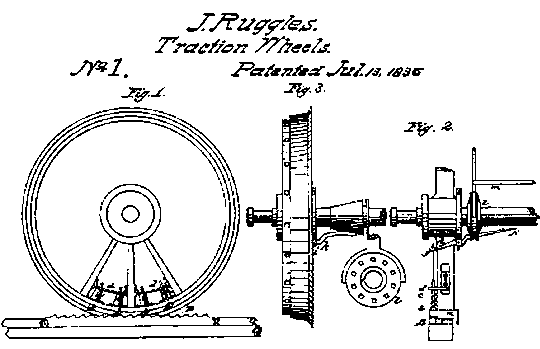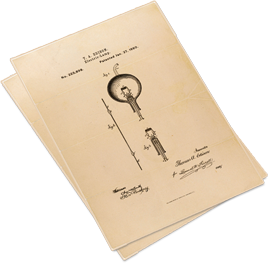Bohan Mathers has over 30 years of experience prosecuting patent applications before the United States Patent and Trademark Office, successfully obtaining hundreds of patents for its clients. With Bohan Mathers, you can be confident that you are getting the advice and representation you need to properly protect your intellectual property.
U.S. Patents, Historically… 
The first U.S. patent was granted in 1790 for a method of producing potash. When the patent office burned to the ground in 1836, all patent records were lost, and records of only about 2000 of the almost 10,000 patents granted before then have been recovered.
In 1836, the new patent office granted Patent No. 0000001 to John Ruggles of Thomaston, Maine, for his system to assist locomotives in climbing steep grades.
Nearly 30 years later, during the 1860s, using technology based on, and perhaps derived directly from the Ruggles patent, the Mt. Washington Cog Railway was built to transport passengers and equipment to the summit of Mt. Washington in New Hampshire. Today, the Mt. Washington Railway is still in daily use.
U.S. Patent Law, Essentially…
Today, a patent is a covenant between a government, representing the public interest. The inventor of a novel, useful technology (the “invention”) by which, in return for publicly disclosing (“teaching”) the details of the invention, the inventor is granted exclusive property rights to the invention and its use for a specified period of time. In the United States, a patentable technology can be a mechanical or electronic device or apparatus.
A living “manufacture,” such as an animal, plant, virus, or bacteria not produced by natural means. A new composition of matter, such as a chemical compound, or a molecule, or a chain of molecules. A process or the product of a process, including a process defined embodied in a computer. In certain instances, a design. The fundamental requirements of any patentable invention, however, are that it be useful and novel, not obvious or anticipated.
A patent grants to the patent holder the right to exclude all others from manufacturing, selling, or using (“practicing”) the patented device, product, or process for the duration of the patent’s term. For U.S. patent applications filed after June 8, 1995, the term of a patent is 20 years from the filing date of the application. This is true of most other countries as well.
U.S. patent rights are secured if the U.S. Patent and Trademark Office (PTO) issues a patent. In general, international patent rights may only be secured by applying for patent protection in each country, separately. However, international agreements, such as the Patent Cooperation Treaty, and consolidated patent offices, like the European Patent Office, aim to streamline the acquisition of patent rights throughout the world.
U.S. Patent Applications…
U.S. patents are issued in the name of the individual or individuals who invented the new technology. Inventors may sell or otherwise assign some or all of their rights in a particular invention to another individual, a business entity, or even a government.
Often under the terms of the inventors’ employment, for instance. Such an assignee may take an active role in the patent application process. Nevertheless, credit for inventions is always attributable to inventors as individuals. Corporations cannot be inventors.
In general, an invention is patentable only if not already “in the public domain.” In the United States and Canada, once an invention has been publicly used or disclosed, the inventor has one year to file a patent application for it. For other countries, any public disclosure may render the invention non-patentable.
Traditionally in the United States, the contents of a patent application have been confidential. It would remain so until a patent is issued. Unless the inventor chose to disclose the invention. The practice in most other countries is to publish the patent application 18 months after it is filed, making public disclosure of the invention.
Recent changes in U.S. law brought U.S. practice more in line with the rest of the world, mandating that U.S. patent applications filed after November 29, 2000, be published 18 months after filing unless the inventor declares no intention to seek patent protection outside the U.S.
A patent application contains a narrative description of the invention and itemizes the details of the invention claimed by the applicant to be novel and protectable by patent (the “claims”). In addition, the application must contain the name of the inventor and the title of the invention.
A patent application usually contains a drawing illustrating the narrative. It must contain any further information necessary to describe the invention. While there are variations from country to country in particular requirements and conventions, the form of the patent application is essentially the same.
For instance, the application must usually be written in the language of the country in which patent protection is sought. Once filed, the claims made in the patent application are examined for novelty and usefulness. In light of the history of the invention within the particular technology embodied in, or related to, the claimed invention.
The Patent Classification System helps to identify the historical and technological characteristics that a particular invention possesses. It helps to locate all of the previously disclosed inventions similar to the claimed invention.
Patent examiners typically have some skills in each area of technology for which they examine patent applications. In the United States, a technical degree, usually at least a Bachelor of Science, is required both for patent examiners, the patent agents, and patent attorneys admitted to practice in the U.S. PTO.
The Patent Application Process…
In essence, it is a negotiation between the patent examiner and the inventor that usually lasts for months or years. The examiner seeks to exclude those claims that they consider to describe devices, processes, or compositions of matter disclosed in, or obvious from, previous patents or that became otherwise publicly known, prior to the filing of the application.
This “prior art” may be a single reference describing the applicant’s invention exactly, or it may comprise several references taken together. The inventor, on the other hand, attempts to justify the creativity, inventiveness, novelty, and usefulness of each and every facet of the invention claimed.
Patent Pending Status…
Once a U.S. patent application has been filed with the PTO, and as long as it remains active, the claimed invention has “Patent Pending” or “Patent Applied For” status. These terms, affixed to or associated with a publicly shown or traded product or process, puts others on notice that the inventor claimed and may acquire, patent protection for the product, process, or for some part of it.
Patent Pending status by itself does not provide any legal protection for the claimed invention, and the law provides for sanctions for false or improper use of the Patent Pending label and its equivalents. However, the publication of the patent application automatically after 18 months, or at the inventor’s request does afford limited enforceable protection from infringement of the invention before the patent is issued.
Post-Issuance…
Once granted, and for the duration of the term of the patent, only the inventor or assignee (i.e., the patent holder) may determine whether and by whom the patented invention may be practiced. It is not a requirement of U.S. law that new technology is used, only that it be useful.
On the other hand, to maintain patent rights throughout the full term of the patent, the patent holder must meet certain obligations. In the U.S., documents must be filed. Maintenance fees must be paid prior to the 4th, 8th, and 12th anniversaries of the patent issuance date. Furthermore, the patent holder holds an obligation to protect and defend the rights granted under patent law.
Just as permitting the public to freely cross one’s property may lead to the permanent establishment of a public right of way and the diminishment of one’s property rights. The knowing failure to enforce one’s patent rights against infringement by others may result in the forfeiture of some or all of the rights granted in a particular patent.
U.S. patent rights, limited to the right to stop others from making, using, or selling the invention in the U.S. and its territories and possessions, are enforced through actions in the U.S. Federal Courts. In general, infringement of patent rights granted by a particular country must be prosecuted in the court system of that country.
Patent Protection in Other Countries…
Patent protection is a national matter. Protection must be sought in each country in which patent protection is desired. Public disclosure prior to filing the patent application severely limits the ability to gain patent protection outside the United States and Canada.
Generally, an inventor in the U.S. who has not publicly disclosed an invention has one year after the initial filing date of a U.S. patent application to file for patent protection in all other countries, including an application filed under the Patent Cooperation Treaty. The invention may be publicly disclosed thereafter. During the ensuing year, without negating the opportunity to seek patent protection outside the United States.
The year after the application’s filing is not a strict limit. However, it only applies when an invention is publicly disclosed after filing. In all other cases, as long as an invention has not been publicly disclosed, the patent application has not been published, and the patent has not been issued, an inventor may generally file for patent protection in any country.
In general, each country determines the priority of the inventor’s claims by the application filing date. Or, by the filing date of an application under the Patent Cooperation Treaty. Naming one or more countries in which the inventor intends to seek patent protection. The filing of an application under the Patent Cooperation Treaty also extends the time in which each national application must be submitted in each of the named countries.



